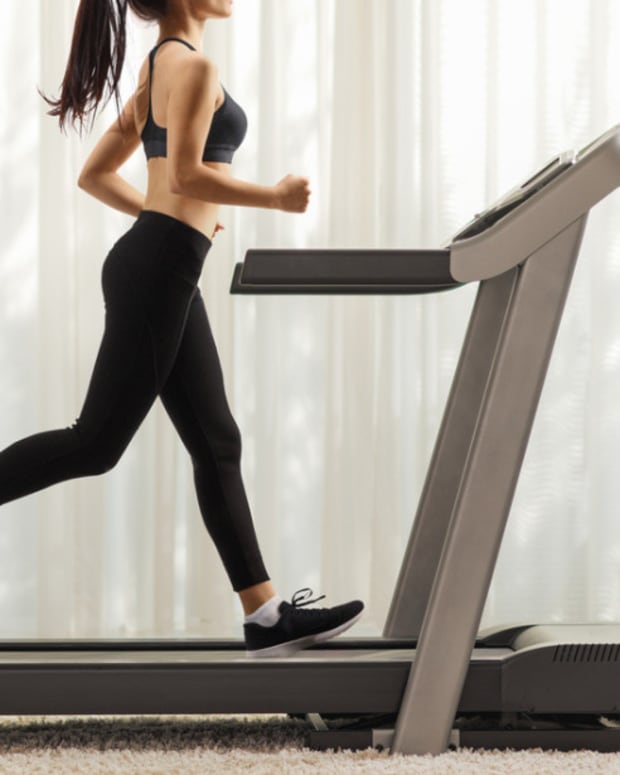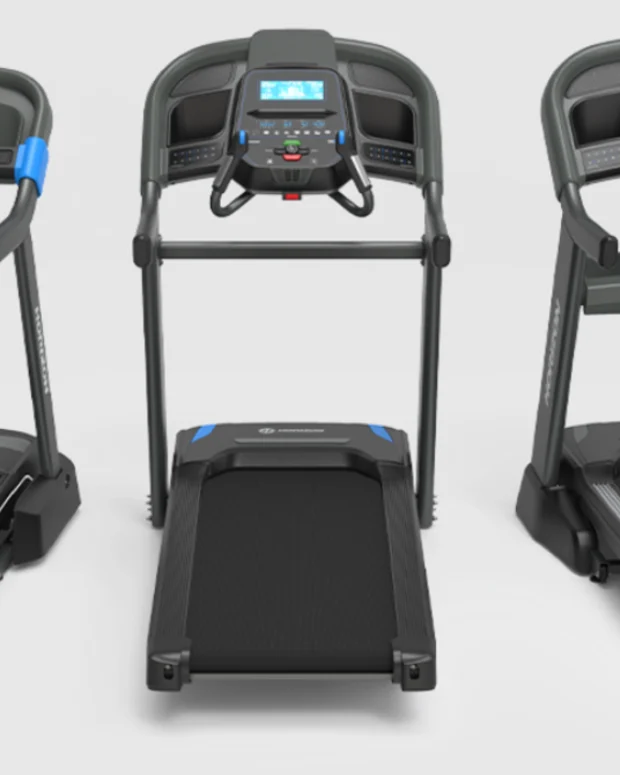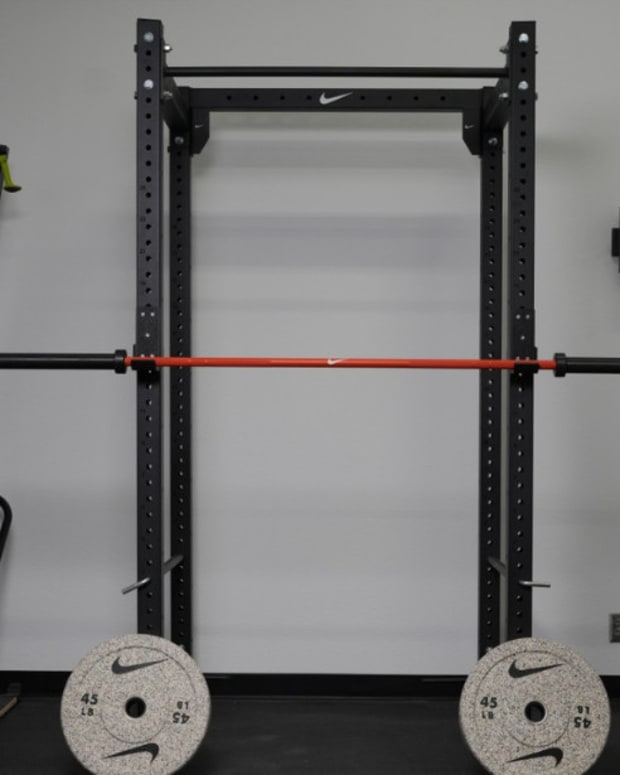The products featured in this article have been independently reviewed. When you buy something through the retail links on this page, we may earn commission at no cost to you, the reader. Sports Illustrated editorial staff are not involved in the creation of this content. Learn more here.
Your heart rate is a huge indicator of health and fitness, and changes in it can be a red flag that you’re getting sick or a positive sign that your workouts are starting to pay off. A heart rate monitor can be a powerful tool for staying on top of your stats. But not all heart rate monitors were created equal. Some are budget-friendly with few bells and whistles but sync with popular fitness apps and equipment, while others are built right into fitness trackers and have all kinds of smartphone features.
Either way, they’re easy to use and wear: Just strap one around your chest, wrist or arm, and sync it to whichever device you prefer (your phone, a watch, a treadmill or bike) to see real-time data 24/7. Whether you’re merely tracking your steps to hit your daily movement requirements or looking for in-depth workout insights, the right heart rate monitor from the list below can help you hit your goals.
Our Picks for the Best Heart Rate Monitors of 2024:
- Best Heart Rate Monitor Watch: Garmin Venu Sq 2
- Best Fitness Tracker with Heart Rate Monitor: Whoop
- Best Heart Rate Monitor Watch for Heart Patients: Polar H10 Heart Rate Sensor
- Best Heart Rate Monitor for Cycling: Wahoo Tickr
- Best Heart Rate Monitor for Running: Coros Pace 2
- Best Heart Rate Monitor Chest Strap: Polar H9 Heart Rate Sensor
- Best Armband Heart Rate Monitor: Wahoo Tickr Fit
- Best Wrist Heart Rate Monitor: Fitbit Inspire 3
- Best Heart Rate Monitor for Peloton: Peloton Heart Rate Band
Best Heart Rate Monitor Watch: Garmin Venu Sq2
Key Features:
- Health Snapshot feature records key stats from a two-minute session
- Syncs to Garmin Connect app/website for very in-depth analytics
- Up to 11 days of battery life in smartwatch mode
The Venu Sq2 is a great entry-level heart rate monitor in a watch. Not only does the optical sensor track heart rate every second 24/7, the watch uses that data to tell you your daily resting heart rate, send abnormal heart rate alerts (whether it’s high or low), track your respiration rate, assess your stress levels and develop sleep insights. Plus, the Garmin watch has 28 sports tracking modes, includes preloaded workout suggestions and allows you to build your own workouts from 1,600 exercises in the app and sync them to the watch.
Specs
- Style: Wristband
- Sensor Type: Optical
- Battery Life: Up to 11 days in smartwatch mode, up to 26 hours in GPS mode
- Connectivity: Bluetooth and ANT+
- Waterproof?: Yes
- Adjustable?: Yes
- Metrics Tracked: Heart rate, heart rate variability, respiration rate, stress, sleep, blood oxygen saturation, steps, distance covered, calories, intensity minutes
- Price: $249
Pros:
- Touchscreen AMOLED (Active Matrix Organic Light Emitting Diodes) display is very easy to use
- Excellent battery life with a low power mode that extends life
Cons:
- No altimeter for stairs or elevation tracking
- No audible alerts
Best Fitness Tracker with Heart Rate Monitor: Whoop
Key Features:
- Tracks recovery metrics to tell you how prepared you are for a workout
- Can be recharged without having to be taken off the wrist
- Subscription model that includes the Whoop wearable
Whoop was the first wearable to prioritize recovery over fitness, and it does that by focusing on heart rate variability, or the amount of time between each heart beat. The higher your HRV is compared to your average, the more ready you are to tackle an intense workout. The Whoop 4.0 uses that data to provide super personalized recommendations in the app, like how hard you should work out each day based on stress levels and sleep, or how much extra sleep you need each night to make up for excess stress (whether that’s from exercise or prepping for a presentation at work).
Specs
- Style: Wristband
- Sensor Type: Optical
- Battery Life: Three to four days
- Connectivity: Bluetooth
- Waterproof?: Yes
- Adjustable?: Yes
- Metrics Tracked: Heart rate, heart rate variability, strain, sleep, recovery
- Price: $30 per month
Pros:
- Generates customized weekly and monthly performance assessments
- Offers in-depth sleep measurements and recommendations
- Compatible with Whoop Body, which allows you to wear the sensor elsewhere on your body
Cons:
- Requires a monthly subscription
- No screen
- Data may be too intense/overwhelming for casual wearers
Best Heart Rate Monitor Watch for Heart Patients: Polar H10 Heart Rate Sensor
Key Features:
- Considered one of the best heart rate monitors in terms of accuracy
- Comfortable fit that doesn’t budge
- Slip-preventing silicone dots to keep the strap in place
The H10 is the most accurate heart rate sensor in Polar’s history, according to the company; in fact, it’s often used by medical researchers and other brands looking to validate the accuracy of their devices. What sets the H10 apart is the fact that it uses extra interference-preventing electrodes and slip-preventing silicone dots to keep the strap snug around your chest no matter what you’re doing, guaranteeing reliable readings at any given moment. Even better: You can get the “gold standard” in heart rate monitoring for under $100.
Specs
- Style: Chest strap
- Sensor Type: ECG
- Battery Life: Up to 400 hours
- Connectivity: Bluetooth and ANT+
- Waterproof?: Yes
- Adjustable?: Yes
- Metrics Tracked: Heart rate, heart rate variability
- Price: $89.95
Pros:
- Dependable accuracy
- Budget-friendly price
- Supports two simultaneous Bluetooth connections
Cons:
- Non-rechargeable battery
- Polar app is not as good as competitors
- Only tracks heart rate and heart rate variability
Best Heart Rate Monitor for Cycling: Wahoo Tickr
Key Features:
- Budget-friendly version of the brand’s more expensive models
- Supports up to three simultaneous Bluetooth connections
- Syncs with over 50 third-party apps
The Wahoo Tickr’s recent redesign makes it one of the lightest and slimmest heart rate monitors on the market—ideal for anyone who doesn’t want to be distracted by a chest strap, especially when you’re in the saddle for hours. The Tickr measures heart rate, calorie burn and workout duration in real-time with the Wahoo Fitness app, but also syncs to over 50 third-party apps, like Peloton and Zwift. Plus, with ANT+ and Bluebooth, you can beam your data to multiple devices—like a watch, bike computer and laptop—at the same time.
Specs
- Style: Chest strap
- Sensor Type: ECG
- Battery Life: Up to 500 hours
- Connectivity: Bluetooth and ANT+
- Waterproof?: Yes
- Adjustable?: Yes
- Metrics Tracked: Heart rate, calories burned, workout duration
- Price: $49.99
Pros:
- Very affordable
- Long battery life
- Works with over 50 third-party apps
Cons:
- Non-rechargeable battery
- Band loses elasticity over time
Best Heart Rate Monitor for Running: Coros Pace 2
Key Features:
- At just 29 grams, it’s one of the lightest running watches on the market
- Offers up to 20 days of 24/7 heart rate tracking
- Up to 20 days battery life
Eliud Kipchoge—the fastest marathoner in the world—wears this watch. Even if you’re running half as fast, you’ll appreciate how lightweight this watch is and the accuracy of the GPS and heart rate sensor. Switch between road, treadmill and track modes to monitor stats like cadence, stride length, ground contact time, elevation and more. Then dig into your post-workout data in the partner app or sync it to third party apps including TrainingPeaks, Strava, Apple Health, Stryd, Final Surge and Runalyze.
Specs
- Style: Wristband
- Sensor Type: Optical
- Battery Life: Up to 20 days
- Connectivity: Bluetooth and ANT+
- Waterproof?: Yes
- Adjustable?: Yes
- Metrics Tracked: Heart rate, altitude, pace, temperature, barometric pressure, calories, steps, power
- Price: $200
Pros:
- A proprietary algorithm ensures track workouts are measured accurately, regardless of which lane you choose
- Strength Training program in the partner app has over 200 built-in exercises
- More affordable than comparable running watches
Cons:
- Does not track trail running
- Doesn’t offer many smartwatch features
- Not ideal for casual runners or those interested in multiple sports
Best Heart Rate Monitor Chest Strap: Polar H9 Heart Rate Sensor
Key Features:
- High-quality sensor for affordable price
- Good for both beginners and multisport athletes
- Pairs via both Bluetooth and ANT+
The Polar H9 Heart Rate Sensor is a great all-around heart rate monitor, whether you’re a beginner or a multisport athlete. It doesn’t come with any fancy features, but it hits all the essentials: The soft, stretchy strap is comfortable, the electrical sensor is waterproof and it can be paired with any ANT+ or Bluetooth-compatible devices. For anyone looking to pair a reliable heart rate monitor with other wearables or gym equipment, the H9 will get the job done admirably.
Specs
- Style: Chest strap
- Sensor Type: ECG
- Battery Life: Up to 400 hours
- Connectivity: Bluetooth and ANT+
- Waterproof?: Yes
- Adjustable?: Yes
- Metrics Tracked: Heart rate
- Price: $59.95
Pros:
- Very accurate tracking
- Affordable price
- Strap is soft and stretchy for comfort
Cons:
- Non-rechargeable battery
- Fewer features than other Polar heart rate monitors
Best Armband Heart Rate Monitor: Wahoo Tickr Fit
Key Features:
- Tracks multiple metrics in the Wahoo Fitness app
- Comes with two armbands (a 10-inch and a 15-inch)
- Worn around the forearm or upper arm instead the wrist or chest
Not everyone wants to wear a tight strap around their chest during workouts. Wahoo solves for that with the Tickr Fit, which uses the same accurate heart rate tracking technology you’d find in their chest straps, only in this case, it’s in an armband. With two sizes included, you decide whether you want to wear it on your forearm or upper arm (the tracking results will be the same). It pairs easily with Wahoo's trainers and GPS units, and works with any other Bluetooth or ANT+ device.
Specs
- Style: Arm band
- Sensor Type: Optical
- Battery Life: Up to 30 hours
- Connectivity: Bluetooth and ANT+
- Waterproof?: Yes
- Adjustable?: Yes
- Metrics Tracked: Heart rate, calorie burn, workout duration
- Price: $79.99
Pros:
- Rechargeable battery
- Strap is made from advanced performance materials for comfort and durability
- Works with over 50 third-party apps
Cons:
- Can't see heart rate or zones on sensor itself
- Can be annoying to wear with long sleeves
Best Wrist Heart Rate Monitor: Fitbit Inspire 3
Key Features:
- Tracks in-depth sleep data and will gently wake you at the optimal sleep stage
- Automatically tracks your time in heart rate zones, whether you’re exercising or not
- Up to 10 days battery life
Fitbit’s lightweight Inspire 3 is one of the less obtrusive offerings from the OG wearable company. It’s slimmer than most wrist-based heart rate monitors, but doesn’t skimp on features: 24/7 heart rate tracking informs data like calories burn, sleep stages, resting heart rate and more. If your resting heart rate is above or below your usual range, you’ll get notified in the Fitbit app, and you can use the device to check for signs of an irregular heart rhythm that may be atrial fibrillation (AFib) and pass that information along to your healthcare provider.
Specs
- Style: Wristband
- Sensor Type: Optical
- Battery Life: Up to 10 days
- Connectivity: Bluetooth
- Waterproof?: Yes
- Adjustable?: Yes
- Metrics Tracked: Heart rate, heart rate variability, respiration rate, stress, skin temperature, sleep, blood oxygen saturation, steps, distance covered, calories, Active Zone minutes
- Price: $99.95
Pros:
- At 30 grams, it’s very lightweight
- Tons of accessory options available for personalization
- Budget-friendly
Cons:
- Some features, like Daily Readiness Score and monthly Wellness Reports, are only available with Premium membership ($79.99/year)
- No built-in GPS
Best Heart Rate Monitor for Peloton: Peloton Heart Rate Band
Key Features:
- Designed to work specifically with Peloton products
- Supports Peloton’s Strive Score metric, which measures how long you spend in a specific heart rate zone to determine workout intensity
- Displays your heart rate on your Peloton screen
Peloton’s Bikes and Treads do work with third-party heart rate monitors, but if you’re a dedicated indoor rider or runner, it’s worth investing in the company’s own armband to optimize your workouts. Not only does it beam your heart rate onto your machine’s screen as you work out, it also has five multi-color LED lights on the front to show your heart rate zone at a glance. And if you don’t have a Peloton device (or you have cardio machines from two different companies), you can still rock this: It will work with third-party gym equipment and apps, as long as they support Bluetooth connectivity.
Specs
- Style: Arm band
- Sensor Type: Optical
- Battery Life: Up to 10 hours
- Connectivity: Bluetooth
- Waterproof?: Yes
- Adjustable?: Yes
- Metrics Tracked: Heart rate
- Price: $90
Pros:
- Rechargeable battery
- Stretchy knit armband with Velcro fastener comes in small and large sizes
- Works with gym equipment and apps not associated with the Peloton brand
Cons:
- No ANT+ connectivity
- Wide, 1.5-inch strap may feel bulky on some arms
Why Buy a Heart Rate Monitor?
Heart rate monitors track your heart rate 24/7, which allows you to gauge your intensity during workouts, monitor stress levels throughout the day, review sleep quality and stay on top of your vital signs. For example, take your resting heart rate, or the number of times your heart beats per minute when you’re at rest (like first thing in the morning): A low resting heart rate is a hallmark of cardiovascular fitness and efficiency, while a higher resting heart rate has been associated with a higher risk of cardiac events. When your resting heart rate is suddenly higher than normal, it could be a sign of stress (whether that’s from work, having a few drinks last night or because you’re coming down with a cold). Tracking your heart rate and understanding what’s normal for you can be an empowering way to stay on top of your health.
Types of Heart Rate Monitors
A heart rate monitor can use two different approaches to detect your heart rate or pulse rate: Electrocardiography (ECG) sensors—or electrodes—track the electrical current generated with every heartbeat. Optical sensors use photoplethysmography (PPG)—a process that requires shining infrared light through your skin—to measure the changes in your blood volume.
Styles of Heart Rate Monitors
The two most common styles of heart rate monitors are chest straps and wrist-based wearables. Chest straps generally use ECG to detect the heart’s electrical activity as it beats. Wrist-based wearables typically employ PPG via light-emitting diodes (LEDs) on the bottom of the device that shine light into the two major arteries in your forearm and wrist.
Companies are starting to get more creative with where you can wear a heart rate monitor, though. Oura, for example, is a smart ring that uses PPG to track your heart rate, while Whoop, which also uses PPG, has expanded beyond its wrist band to offer WHOOP Body, a line of technical and everyday garments that enable members to wear the sensor across multiple locations on the body, including in sports bras, leggings, shirts, arm sleeves, shorts, and boxer shorts.
ANT+ vs Bluetooth
In order for you to see your data, heart rate monitors need to be able to connect with other devices, whether that’s your smartphone, a watch or a piece of equipment. There are two ways heart rate monitors do that: ANT+ or Bluetooth.
ANT+, which stands for interoperability, uses a 2.4 gigahertz ultra-low power wireless network to broadcast information. You don’t need to pair any devices; when you send an ANT+ signal, the nearest compatible ANT+ receiver is able to pick it up. This allows products from multiple brands to work together, and multiple users to view the same data in real-time.
Bluetooth also operates at a 2.4 gigahertz frequency, but it requires pairing between two devices. Once a connection has been made, no other devices can connect to the same device. Bluetooth can transmit data significantly faster than ANT+, which is preferred when you’re training with heart rate data and need second-by-second updates.
How to Choose the Best Heart Rate Monitor for You
Forms of exercise
Any form of exercise can benefit from a heart rate monitor, from walking to swimming. For the most part, people tend to wear heart rate monitors during aerobic (or cardio) exercise.
Intensity of physical activity
The higher the intensity of your activity, the more likely you’ll want a higher-end wrist-based heart rate monitor or a chest strap. The chest strap is generally considered to be superior to wrist-based heart rate monitors during high-intensity exercise. For example, wrist-based monitors were shown to become less accurate as runners went faster in a 2019 study in the journal Cardiovascular Diagnosis & Therapy.
Style/fit
A wrist-based heart rate monitor is just like a watch (and sometimes may even double as one) and should sit right above the wrist bone. A chest strap should sit just below your sternum or under your chest muscles. If you’re not accustomed to wearing one, it may take a few wears to get used to. An arm band can be worn on the upper forearm, biceps or triceps. Most heart rate monitors are adjustable for a customized fit, and should be worn snugly with the sensors against the skin in order to get the most accurate readings.
Connectivity
Many heart rate monitors are capable of connecting to both Bluetooth and ANT+. When you’re considering a monitor that only connects to one or the other, think about how you’ll view your data. If you want to see your heart rate information on a cycling computer, piece of gym equipment or laptop, you’ll want to ensure it has ANT+ connectivity. If you’re only interested in viewing it on your smartphone or a watch, then Bluetooth will be good enough.
Metrics
Some heart rate monitors measure only heart rate. Others track calories burned, distance covered and workout duration. Wrist-based heart rate monitors, which are generally part of a fitness tracker, will provide the most metrics, including respiration rate, stress levels, skin temperate, sleep, blood oxygen saturation, steps, distance covered, calories and more, depending on the number of sensors in the device.
Related Post: Garmin Index BPM Review
Versatility
While chest straps and arm bands generally only track basic metrics, a wristband can double as a smartwatch and fitness tracker. Those kinds of devices can receive messages, send reminders, share health info and more around the clock.
Battery
Many heart rate monitors—whether chest straps or wrist-based wearables—are rechargeable, giving you anywhere from 10 hours to several days of use on a single charge. But a number of chest straps still rely on changeable coin cell batteries for juice. If you buy a battery-powered chest strap, make sure to separate the sensor from the strap any time you’re not wearing it to extend the battery life.
Budget
For the most part, the lower the price point on a heart rate monitor, the less bells and whistles it will include. More expensive models tend to have more features and track more metrics, but you can absolutely get a reliable, basic heart rate monitor for under $50.
Heart Rate Monitor FAQs
Are heart rate monitors accurate?
A 2020 systematic review of 158 studies found that, in laboratory-based settings, heart rate measurements by Fitbit, Apple Watch and Samsung were variable, with Apple Watch and Garmin being the most accurate and Fitbit tending toward underestimation. A 2019 study in the Journal of Sport Sciences found error rates between 2.4 and 13.5 percent in heart rate tracking for the Apple Watch and Fitbit Charge 2. Even in laboratory settings, device error was higher for males, darker skin tones and those with higher body mass indexes, according to a 2017 study published in the Journal of Personalized Medicine. That doesn’t mean you shouldn’t use a heart rate monitor. When looking at heart rate data, the most important thing is to figure out what’s normal for you and then pay attention to trends and patterns.
Is pulse the same as heart rate?
These two terms are often used interchangeably, but they’re not quite the same thing, according to the Cleveland Clinic. Your heart rate is the number of times that your heart beats in a minute. Your pulse is a way of feeling how many times your heart beats; it’s a result of the pressure in your arteries briefly increasing as your heart pushes out more blood.
What are healthy resting and active heart rates?
A normal resting heart rate for adults ranges from 60 to 100 beats per minute, according to the Mayo Clinic. The more fit you are, the lower that number may be. A resting heart rate faster than 100 beats per minutes is known as tachycardia, while a resting heart rate slower than 60 beats per minute is considered bradycardia. Neither of these is inherently bad, but may be of concern if they’re accompanied by symptoms like shortness of breath, dizziness, weakness or chest pain.
During activity, a “normal” heart rate will be entirely dependent on your age, gender, weight, fitness history and a number of other factors. One way to determine a good active heart rate is to calculate your maximum heart rate (you can use the formula “220 minus your age”). Your target heart rate zone during moderate intensity activities is about 50 to 70 percent of your maximum heart rate, while during vigorous physical activity it’s about 70 to 85 percent of your maximum heart rate.
Is a chest or wrist heart rate monitor better?
A JAMA Cardiology study published in 2017 found that wrist-based heart rate monitors were not as accurate as chest strap monitors. Chest strap sensors are placed closer to the heart than in a wristband and use ECG technology, which may provide more precise measurements than PPG. But wrist-based heart rate monitors are certainly good enough for the majority of the population to use when tracking activity, sleep or stress levels; it will more likely come down to comfort level and whether you prefer to wear a tight band around your chest or something akin to a watch on your wrist.
Final Thoughts
If you’re interested in learning more about your health or your performance, a heart rate monitor can be a low-cost way to stay on top of things and even gain an edge in training. Just remember that these devices aren’t perfect, and it’s still important to listen to your body and learn what’s normal for you—and you should always see a doctor if you have concerns.
Prices are accurate and items in stock as of publish time.


















